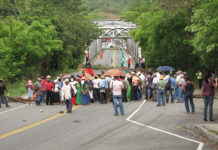
Concerned by the destructive advance of the Bonyic hydroelectric dam, a group of Naso protestors are now making an urgent plea for international solidarity.
Tensions are mounting in the indigenous Naso territory in Bocas del Toro province, western Panama, where protestors have blocked access to the Bonyic Hydroelectric project, a 30MW dam currently under construction on the banks of the Bonyic river.
The Naso are one of Panama’s most marginalised indigenous groups, currently numbering approximately 4000. Their populations are concentrated in eleven different communities on the forested banks of the Rio Teribe, which they call Tjer’di (Grandmother Water) – a vital source of material and spiritual sustenance. Living in relative isolation for centuries, the Naso have retained many aspects of their pre-Columbian culture, including a monarchy – one of the last remaining in Latin America. They are also renowned masters of bush-craft, hunting, fishing and rainforest medicine. Daily life revolves around subsistence farming, and their language, part of the Chibchan family, is critically endangered.
Perched in the heart of their territory, the Bonyic dam, a project of the Colombian company Públicas de Medellin, has been fraught with controversy since its inception six years ago. Notoriously, it caused a schism in Naso society when the then Naso King, Tito Santana, negotiated and reached an agreement with the company without the full consent of his subjects. Today, Tito lives in exile and a volatile situation is once again developing with plans for a new access road and a range of tunnels.
The protestors, who number around 100, say the road will cut through an ancient archaeological site, which has already been damaged by bulldozers. They say the site is extensive and that they have collected a variety of ceramic shards, implements, huacas (pre-Colombian ornaments) and a piece of human bone from the area, indicating it was once perhaps a burial ground.
Sitting at the edge of a makeshift encampment, Ilisa Castillo revealed one such object found in the earth of her finca. Although heavily eroded, it appeared to show signs of carvings. The company has promised to dispatch archaeologists to the area for further assessment, but Castillo is concerned that they may not provide a fair and independent evaluation.
Other protestors are concerned about the leakage of contaminates from the Bonyic project into the Bonyic and Teribe rivers, which the Naso utilise for drinking water.
They reported a discharge, described as ‘whitish’ and ‘grey’, and are now concerned for their health. The Ministry of Health has taken samples of the water, but at the time of collection, operations at Bonyic had ceased for over a week (at which point there was no visible sign of contaminates) – official results of the tests are pending. Beyond the Naso territory, the Teribe river flows into the Changuinola river – a primary source of drinking water for the nearby city of Changuinola.
Finally, compensation remains an on-going issue for some protestors who are still negotiating with the company for the sale of their lands.
Protests began on Friday 14 September with one group assembled close to the gates of the project and another convened on the main road into the territory. The protestors later called a halt to their action pending negotiations. On Wednesday 19 September, talks with the Panamanian Vice-Minister, the company and a select group of Naso leaders, were held in Changuinola to little avail.
The scenes on the main road, where some fifty protestors had assembled close to the banks of the Rio Teribe, saw King Alexis Santana heavily reprimanded for failing to include those most affected by the project in the discussions, and for failing to properly address their concerns. Protests will recommence on Thursday 20 September and there is now palpable anxiety about a possible clash with the police, who have a well-documented history of violence towards indigenous protestors. The area where the protest is taking place is very isolated and the mainstream media are largely ignoring the situation.
Politically, the current troubles in the Naso territory are framed by the wider struggle for autonomy.
“I see the urgent necessity that the naso territory is transformed into a Comarca named Comarca Naso Tjer’di,” said Adolfo Villagra, who runs the Wekso eco-lodge on the banks of the Teribe River.
He believes that a Comarca – a type of semi-autonomous territory that is enjoyed by five of Panama’s eight indigenous groups – will afford the Naso future protection against invasive mega-projects. Additionally, he issued a plea regarding the protection of the territory’s pristine rainforest environment:
“To those groups that recognise that we must care for the environment for future generations, we ask the support of the international community because we have a treasure called La Amistad National Park, world patrimony of humanity. We invite them here that they might know the unique value of what we have in the Naso territory, in the matters of environment, culture and traditions…”
He concluded by saying:
“With regards to human rights, we ask for urgent help to at least relieve the pressure that we have from the government. We have said that we must pay with blood because the government doesn’t listen to us or recognise our land…”
Source: Intercontinental Cry










